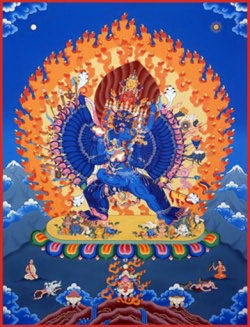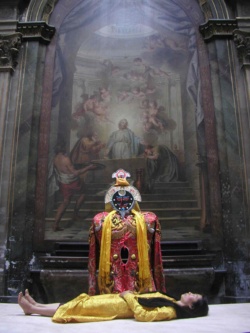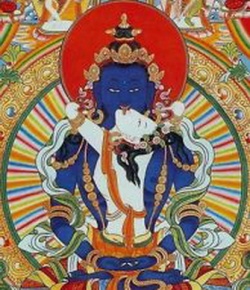Tantra classes in Buddhist yoga
Written by Red Zambala
Yoga in Tibetan Buddhism can be classified in two ways – according to new tradition and according to old tradition.
“The New Tradition” in Tibetan Buddhism means the system of tantra classification and Buddhist traditions which developed after the second coming of Buddhism in Tibet in X century and traditionally it is believed it has started with Rinchen Zangpo (958-1055) and was accepted in Kagyu, Sakya and Gelug traditions.
“The Old Tradition” refers to Buddhism brought to Tibet by Guru Rinpoche and accepted by Nyingma tradition. Thus, the new tradition divides all Buddhist yogas to four tantra classes:
1. Kriya yoga
2. Charya yoga
3. Yoga tantra
And the Upper Tantra:
4. Anuttaratantra.
According to “old tradition” or Nyingma, Buddhist tantra is divided to six classes: Three “external” tantras:
1. Kriya yoga
2. Charya yoga
3. Yoga tantra
And three “inner” tantras:
1. Maha-yoga
2. Anu-yoga
3. Ati-yoga
Here, Inner Tantras are mostly based on methods of purification and preparation to perceive the wisdom of Enlightened beings.
Kriya-tantra (bya ba'i rgyud) particularly emphasizes the significance of rules of behaviour, purity, diets, etc. and visualisation of deities as external to individual.
Yoga-tantras (rnal `byor rgyud)- on opposite – are based on visualizing ourselves in form of deity by rather simple methods of transformation.
Charya-tantras (spyod pa'i rgyud) are somewhat in the middle – similar to Kriya-tantras from viewpoint of ritual behaviour and similar to Yoga-tantras – for visualizing ourselves in form of deity.
Inner tantras, especially first two of them – Maha-yoga and Anu-yoga are based on the principle of transformation of emotions and karmic energies into primordial wisdom.
This practice consists of two phases:
Accumulation (bskyed rim) and
Completion.
During the phase of Accumulation one visualizes the empty space of deity, also called mandala, and the image of deity, called yidam.
During the phase of Completion transforming concentration is focusing inside the three-fold structure of our own body:
nadi or the subtle channels through which energy circulates,
prana – life-force of our body and
kundalini – the essence or potential of this energy.
This method of practice is characteristic to Maha-yoga and corresponds to Anuttara-tantra in the “new” tradition.
Anu-yoga, which is characteristic for old tradition, more emphasizes the meaning of momentary visualization of deity and empty space, and also to phase of Completion.
Ati-yoga, also called “the Primordial yoga” is otherwise called Dzogchen or The Great Perfection and though it is classified as “inner tantra” is not really considered tantric, because its Path is the Path of self-liberation and not the Path of transformation.
While the goal of Ati-yoga is Dzogchen or “Great Perfection”, the final goal of Maha-yoga is Mahamudra or “the Great Seal”.
Ati-yoga is also called “father’s tantra” and is considered to be more suited for people who are dealing with problems created by hate and anger,
while Maha-yoga is called “mother’s tantra” and more suited for people who have to deal with disturbing emotions.
Dzogchen roots from the heavenly Buddha Samantabhadra, while Mahamudra stems from heavenly Buddha Vajradhara.
However, both Buddhas are representations of the same perfect and enlightened nature of our Buddha-mind.
And, while they are similar, but use slightly different methods, both for practice and description of practice, - at the final end they both lead to the realization of potential of our primordial state of mind – pure and untouched Buddha state.
This is how Mahasiddha Araga Karma Chagmed Rinpoche (1613 - 1678), one of the greatest teachers of Karma Kagyu tradition and author of many texts has described why the term “inner tantra” is used:
“Wisdom deity is not anything external, the inner nature of the mind is a deity-yidam, that’s why we say: upper inner tantra.”
Also in the new tradition the Annutara-tantra is divided into three forms:
fathers,
mothers and
non-dual tantra.
Araga has said:
“Dharmasvara, my revered teacher and ruler has said that from essential viewpoint there is no difference between Anuttara-tantras of father, mother and non-dual one or between Maha-yoga, Anu-yoga and Ati-yoga of old tradition.”
Other scholars, both from new and old tradition state the same.
The same have said many great yogis of Mahamudra tradition, for example Saraha and others.
The Second Karmapa Karma Pakshi has said: “Dzogchen and Mahamudra are different by name only, but the essence is the same.
If someone has realized the highest meaning of the unlimited nature of existence, the difference between complete and incomplete disappears completely.”
Mahasiddhi Araga has described the highest meaning of all Buddhist yogas and tantras in the following way:
The Essence, which is emptiness, is Dharmakaya;
The nature, which is clear light, is Sambhogakaya;
The uninterrupted manifestation of Energy – Nirmanakaya;
The unity of all three is Svabhavikakaya.
The nature of four bodies is Enlightenment:
This way we find our Refuge in Final Enlightenment,
Recognized as the nature of our own mind,
Inexpressible and inconceivable state – The mother of all Enlightened beings (Prajnaparamita)!


